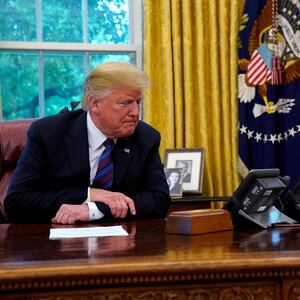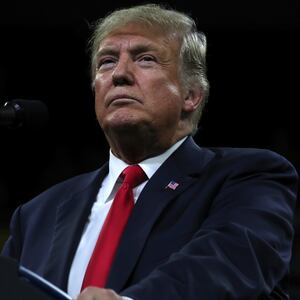On Wednesday afternoon, the Trump administration will send an alert to every cell phone in the country for the first-ever test of the national Wireless Emergency Alert system (WEA), designed to keep Americans informed in times of dire emergency. Here’s what you need to know.
How does it work?
The “Presidential Alert” system builds off of infrastructure that’s been in place for years.
ADVERTISEMENT
After the government was criticized for a lack of communication during Hurricane Katrina, the Atlantic notes, officials created the Integrated Public Alert and Warning System (IPAWS), designed to facilitate emergency communications across multiple platforms. As technology improved, the Wireless Emergency Alert System was developed to incorporate cell phones into the emergency broadcast network.
It’s very similar to an amber alert or a local flood warning, but on a national scale. The message will be sent to wireless carriers, which will then transmit it to cell towers throughout the nation. Anyone in the range of those towers with an alert-compatible device (a smartphone with one of more than 100 participating carriers, including all the major wireless carriers) will receive the alert.
This will be the Federal Emergency Management Agency and the Federal Communications Commission’s first national test of the national WEA system since its inception. It was originally scheduled for Sept. 20—but was postponed to avoid confusion during a real disaster, Hurricane Florence.
The WEA system has been capable of sending alerts for about six years, but neither a test nor a real emergency message has ever been sent through the national system.
Routine testing was mandated under the IPAWS Modernization Act of 2015, and its importance was underscored this January, when Hawaii accidentally sent an alert to all residents reading “BALLISTIC MISSILE THREAT INBOUND TO HAWAII. SEEK IMMEDIATE SHELTER. THIS IS NOT A DRILL.” The error stemmed from a mistaken button press during a shift change—and Hawaii’s residents were not pleased.
When will I get it?
The alert, which will be accompanied by a loud tone and vibration, will be sent at 2:18 p.m. Eastern time/1:18 p.m. Central. The message will be followed two minutes later by a test of the Emergency Alert System (EAS), which will broadcast an alert on radio and television. Both messages will indicate that this is a test, and not a real emergency. It could take up to 30 minutes for the alerts to reach all devices.
Can I opt out?
No. This is a “Presidential Alert,” the highest emergency level supported by emergency notification infrastructure.
In accordance with the 2006 Warning, Alert, and Response Network (WARN) Act, carriers and manufacturers are forbidden from exempting clients from alerts “issued by the President.”
If you don’t want to receive the alert, you can turn your phone off. The message won’t interrupt ongoing phone calls—but it will arrive once the call ends.
You can’t reply to the alerts, so if you feel like giving Trump a piece of your mind, you’re out of luck.
I don’t like this.
You’re not alone. Americans around the country responded with outrage to the announcement, concerned that, as Twitter user @vincefil put it, they would receive messages like “Bigly wet storm coming your way. No collusion!! Witch hunt!”
There was an unsuccessful effort to stop the alerts through the courts. Consumers have called their phone companies to complain, and in some cases, cancel their phone service. There are even resistance hashtags, #phonesoff and #Godark103.
But take solace in this: These messages, while called a “Presidential Alert,” aren’t really from Trump. It’s nothing like drafting a tweet and hitting send without spell check.
While Trump communicates the need for a message to be sent, he is not directly responsible for its contents or the timing of its release. Furthermore, the alerts are by law limited to spreading information about “a natural disaster, act of terrorism, or other man-made disaster or threat to public safety.”
As a result, it’s extremely unlikely—at least in the foreseeable future—that Trump can replace his morning tweetstorms with messages sent directly to Americans’ phones.








